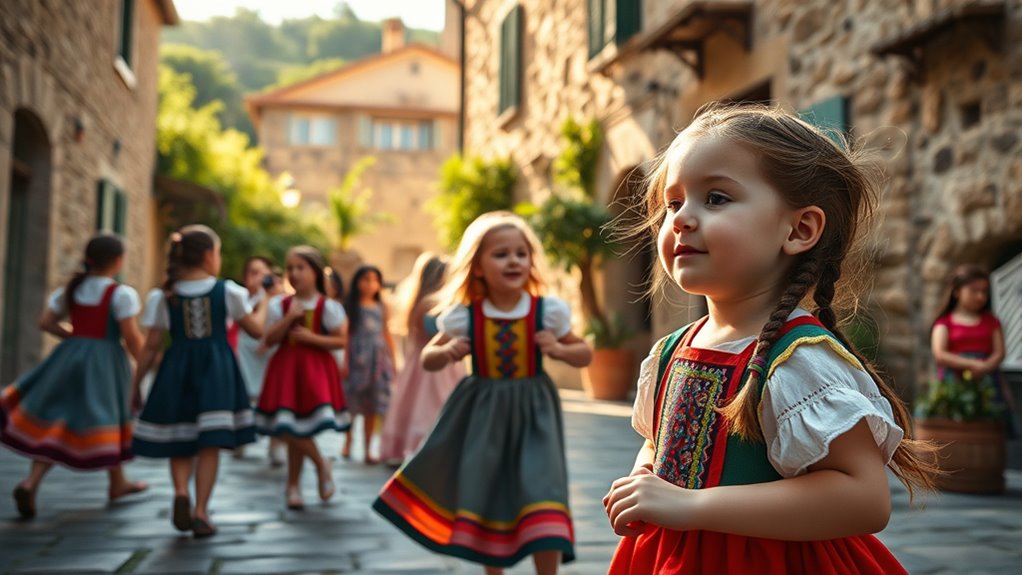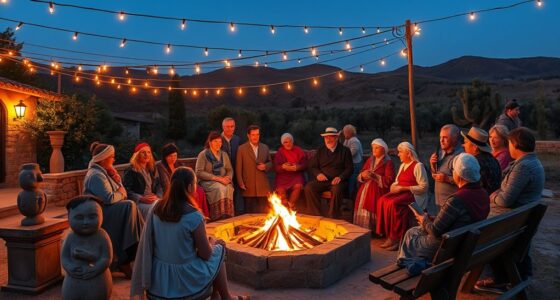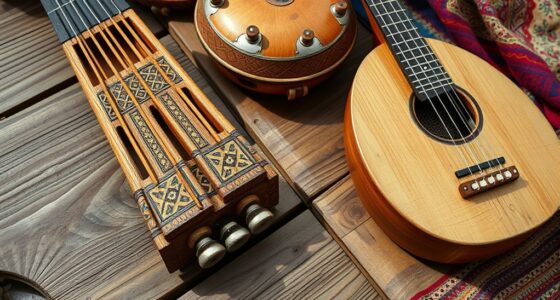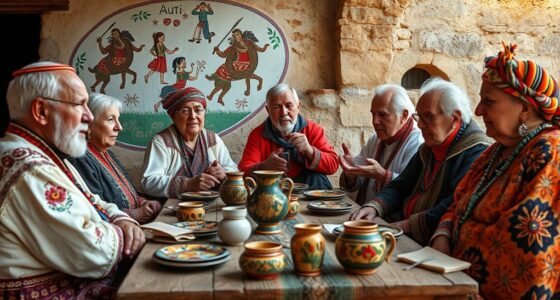Sardinian nursery rhymes and children’s games are rich in cultural meaning, helping you understand the island’s traditions, language, and social values. They often feature themes from daily life, nature, and community stories, using regional dialects and musical rhythms that reflect Sardinia’s unique heritage. These playful activities promote learning, cooperation, and cultural pride. To explore more about how they embody Sardinia’s history and identity, keep exploring these fascinating traditions.
Key Takeaways
- Sardinian nursery rhymes and games preserve regional dialects, cultural identity, and traditional social values through oral storytelling.
- They often feature themes from daily rural life, nature, animals, and community customs, fostering a strong cultural connection.
- Rhythms and movements in these traditions support language learning, motor skills, and social cooperation among children.
- They incorporate unique gestures, musical patterns, and physical interactions that reflect Sardinia’s cultural heritage.
- Preservation efforts include documentation, educational integration, and cultural festivals to safeguard these oral traditions amid modern influences.
The Cultural Significance of Sardinian Rhymes and Play

Sardinian nursery rhymes and children’s games play a vital role in preserving the island’s unique cultural identity. You engage with these traditions daily, passing down oral heritage that reflects Sardinia’s history and language. Rhymes often include local dialects and expressions, reinforcing linguistic pride among young learners. They act as cultural markers, setting Sardinian traditions apart from mainland Italian customs. Through this transmission, you help maintain collective memory and strengthen community bonds. During festivals and seasonal events, these rituals immerse children in Sardinia’s cyclical cultural calendar, deepening their connection to tradition. By participating in these shared practices, you contribute to keeping Sardinian identity alive and vibrant, ensuring that future generations understand and cherish their unique cultural roots. Additionally, studies show that these traditional practices foster a sense of belonging and cultural continuity in Sardinian communities.
Themes and Stories Embedded in Nursery Rhymes
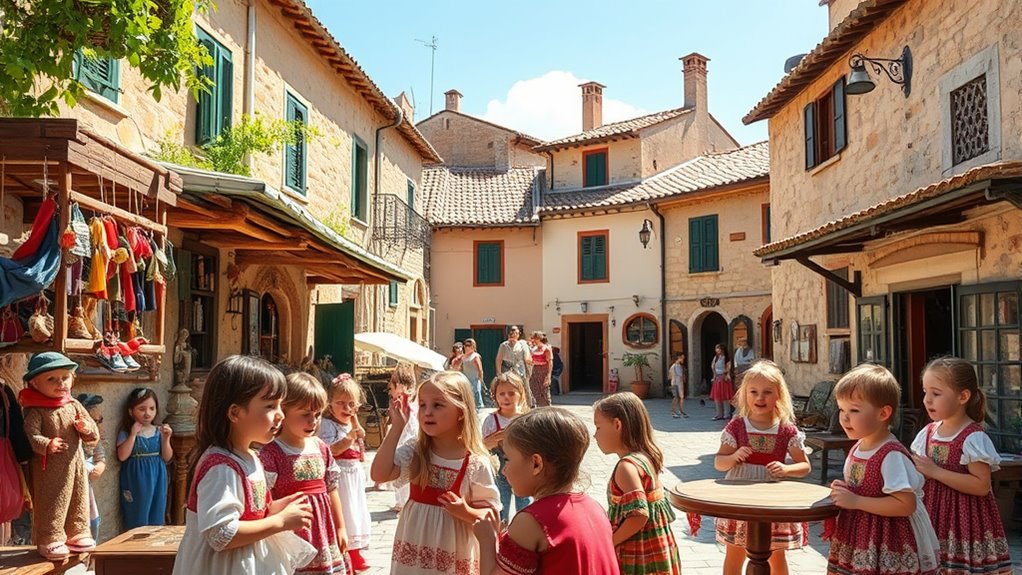
Nursery rhymes often reflect daily life and family roles, showcasing relationships and social expectations children observe early on. Animal imagery and nature themes appear frequently, using characters and settings that connect kids to their environment. These stories embed moral lessons and cultural values, helping children understand their community and surroundings through simple, memorable verses. Additionally, many nursery rhymes incorporate seasonal variations, which can enhance children’s understanding of the natural world and the changing seasons.
Daily Life and Family
Children’s nursery rhymes often serve as a mirror of everyday family life, embedding themes and stories that reflect traditional roles, social customs, and moral values. You might hear about a shepherd named Ramon, representing men’s daily work, or see animals symbolizing familial responsibility. These rhymes also subtly include women and mothers through themes of caretaking, household life, and family care. To paint a picture:
- Stories of shepherds, like Ramon, highlight work and livelihood.
- Animals symbolize family duties and survival.
- Scenes of engagement and marriage reflect social customs and life stages.
- The use of cultural symbols in nursery rhymes helps preserve community values and reinforce social cohesion across generations.
These elements reveal how nursery rhymes encode family roles, social responsibilities, and moral lessons, helping children understand their place within the community and the importance of family bonds.
Nature and Animals
Have you ever noticed how animals and natural elements play a pivotal role in nursery rhymes, shaping children’s understanding of the world around them? In Sardinian songs, animals like pigs, birds, and farm creatures are central, reflecting rural life and familiar scenes. Rhymes like “Cust’ e’ su babbu” highlight animals’ roles in sharing and sustenance. Animal sounds teach children auditory skills, while stories featuring birds and cows foster family bonds and natural awareness. Nature symbols such as stars, night, and water connect kids to natural cycles, and counting games involving animals develop numeracy skills. These rhymes not only entertain but also introduce children to ecological roles, social values, and cultural traditions, blending learning with a deep appreciation for the natural environment. Animal sounds teach children auditory skills. Additionally, engaging with these sounds can improve language development and memory. The use of natural elements in these rhymes also helps children develop a connection to the environment, fostering ecological awareness from a young age.
Linguistic Features and Preservation of Sardinian Language
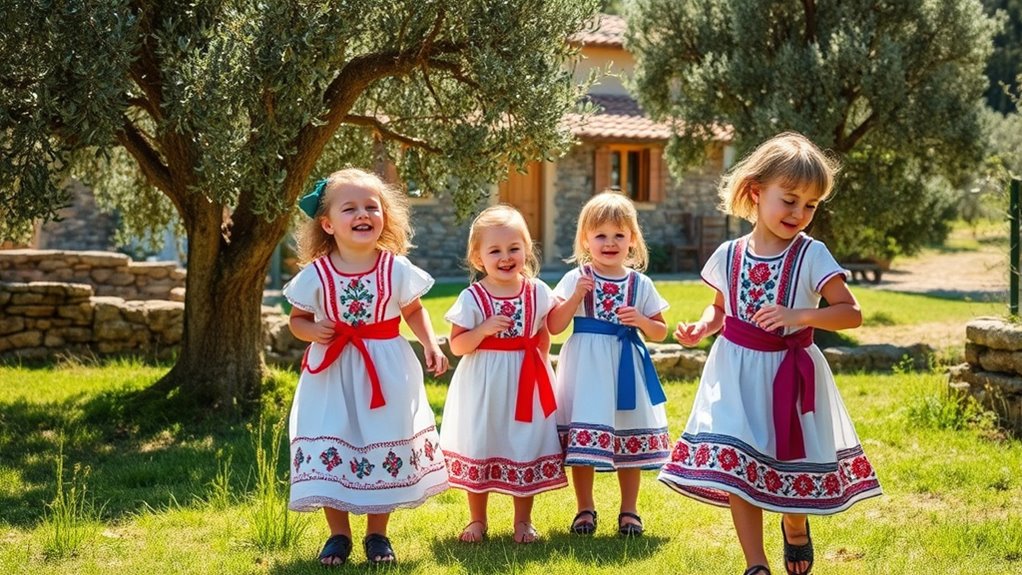
The linguistic features embedded in Sardinian nursery rhymes and children’s games serve as essential repositories of the language’s archaic and regional elements, helping to preserve its unique character amid declining transmission. You’ll notice three key aspects:
- Vocabulary and syntax that retain old Latin roots and regional dialect traits, often absent in adult speech.
- Phonetic patterns like vowel harmony and consonantal structures, distinct from Italian, highlighting Sardinian’s Romance evolution.
- Borrowings and archaic terms that act as informal links to the language’s historical layers. These features are reinforced by linguistic features that are specific to Sardinian, emphasizing its distinct identity within Romance languages.
These features make children’s rhymes crucial for maintaining Sardinian’s linguistic diversity. As oral traditions, they ensure that younger generations continue to connect with their linguistic heritage, despite the dominance of Italian and the decline of active Sardinian use. Preserving oral traditions in these childhood expressions plays a vital role in safeguarding the language’s cultural and linguistic identity for future generations.
Common Games and Their Educational Roles

You can see how traditional Sardinian games help children develop essential motor skills through movement and coordination. These games also teach social cooperation as kids learn to take turns, share, and work together. By participating, children build physical strength and learn important lessons in teamwork and community. Furthermore, engaging in these activities fosters cultural identity and a sense of belonging among young participants. Additionally, these games often incorporate elements of cultural heritage, enriching children’s understanding of their traditions and history.
Promoting Motor Skills
Traditional Sardinian nursery rhymes often incorporate active games that directly promote children’s motor development. You might see children engaging in:
- *Canto e Ballu*, where they dance in circles, improving rhythm, balance, and coordination.
- Chase games embedded in rhymes, encouraging sprinting, quick directional changes, and agility.
- Manipulative activities with small balls or sticks, fostering eye-hand-foot coordination and motor control.
Natural elements like stones for tossing or climbing over branches add variety, developing strength and spatial awareness. These games challenge children’s bodies, promoting muscular development, balance, and coordination. Through repeated movement patterns, children refine motor skills and body awareness, making these traditional games an effective, culturally rooted way to enhance physical development while having fun. Additionally, engaging in raw food diets can support overall health and energy levels, which are important for active growth and development in children.
Teaching Social Cooperation
| Aspect | Focus | Educational Benefit |
|---|---|---|
| Group participation | Rhythmic circle games | Unity and turn-taking |
| Symbolic roles | Finger plays | Attention and synchronization |
| Sharing themes | Rhymes with sharing stories | Fairness and generosity |
| Multicultural exposure | Multiple language versions | Cultural respect |
| Emotional development | Group-based storytelling | Patience and trust |
Rhythmic Structures and Musical Elements
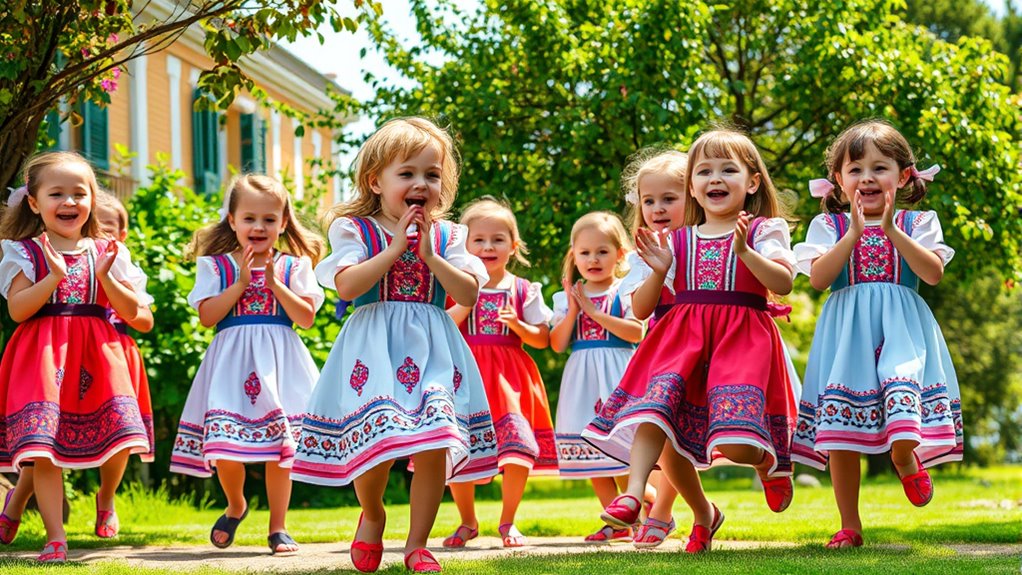
Rhythmic structures in Sardinian nursery rhymes are carefully designed to align with the natural speech patterns and phonetic rhythms of the language, making them easy for children to memorize and repeat. You’ll notice that these patterns often feature:
- Simple duple and triple meters that match everyday speech, helping kids internalize the rhythm effortlessly.
- Rhythms that sync with finger-play games, like in “Cust’ e’ su babbu,” where finger movements follow musical beats.
- Repetitive phrases and clear accents that boost engagement and make learning predictable.
- The use of traditional musical patterns rooted in cultural heritage, which deepen children’s connection to their community and history.
These elements create a lively, interactive musical environment. Minimal syncopation keeps the melodies straightforward, ensuring children follow along and develop a strong sense of timing and rhythm from a young age. Originates from ancient traditions that emphasize the importance of cultural heritage in shaping musical patterns.
Regional Variations and Local Dialects
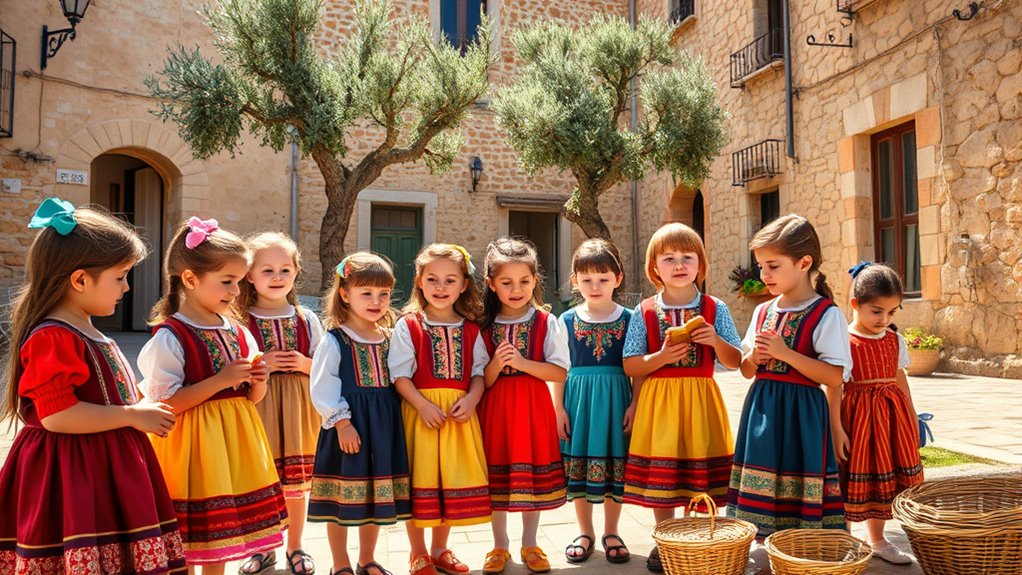
The rich diversity of Sardinian dialects profoundly influences how nursery rhymes and children’s songs are composed and transmitted across the island. You’ll notice regional variations in phonetics, vocabulary, and themes, reflecting local speech communities. For example, Gallurese rhymes feature unique lexical items influenced by Corsican, especially in northern Sardinia. This dialectal richness results from the lack of a unified Sardinian language and limited literacy outside certain areas, preserving oral traditions with regional traits. Local characters, like *sa femmina eccia*, and themes rooted in pastoral life, highlight regional identities. These variations serve as cultural markers and help maintain dialects by fostering intergenerational transmission and pride. Additionally, the promotion of regional dialects through local traditions strengthens community bonds and cultural heritage.
Comparing Sardinian Traditions With Broader Mediterranean Practices

Sardinian nursery rhymes share common features with broader Mediterranean practices, yet they also display distinct cultural and linguistic traits. You notice that:
- Sardinian rhymes often depict rural life, referencing sheep, pigs, and family roles—elements less emphasized in other Mediterranean songs, which tend to focus on stars or everyday domestic scenes. This focus on rural themes highlights the region’s cultural identity and connection to traditional livelihoods.
- Rhythms and games like counting or turn-taking are universal, but Sardinian finger-play rhymes incorporate unique gestures and short, physical interactions.
- Language use varies: Sardinian rhymes are performed in the local language, reinforcing cultural identity, whereas broader Mediterranean practices include a mix of dialects and languages, often with more bilingual presentation.
- The traditional Sardinian songs and games are often passed down orally from generation to generation, helping to preserve the island’s linguistic heritage despite external influences.
These differences highlight Sardinia’s focus on local traditions, preserving its linguistic and cultural uniqueness amidst shared Mediterranean themes.
Challenges and Efforts in Sustaining Folk Children’s Traditions
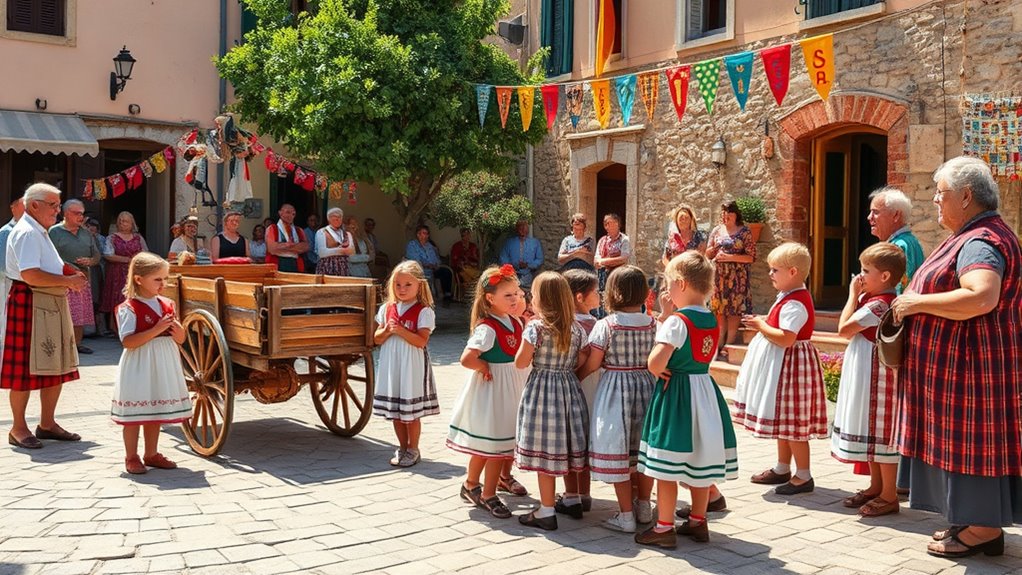
Maintaining folk children’s traditions faces significant challenges due to the dominance of oral transmission and modern influences. Many nursery rhymes and games are never written down, making them vulnerable to fading as younger generations focus on digital media and global pop culture. Dialectal fragmentation hampers understanding and limits dissemination outside local communities. Urbanization and modernization weaken rural practices, reducing natural opportunities for transmission. Additionally, youth interest declines as traditional expressions compete with contemporary entertainment. Efforts to preserve these traditions include documenting songs and games through online platforms, books, and audio-visual materials. Educational programs now incorporate Sardinian folk elements, and cultural organizations host competitions to revive interest. Ethnologists record oral traditions, but linguistic barriers and limited institutional support still pose significant obstacles to keeping Sardinian children’s cultural heritage alive. The lack of formal preservation initiatives further complicates efforts to sustain these vital traditions.
Frequently Asked Questions
How Do Sardinian Nursery Rhymes Influence Modern Sardinian Identity?
You can see that traditional Sardinian nursery rhymes shape modern Sardinian identity by connecting you to your cultural roots. When you sing or learn these rhymes, you preserve local dialects, customs, and values. They help you understand your community’s history and social norms. Even today, these rhymes promote a sense of belonging, fostering pride and continuity in your cultural heritage, despite external influences and modern changes.
Are There Specific Regional Dialects With Unique Nursery Rhymes?
You might think all Sardinian dialects share similar nursery rhymes, but that’s not true. Each regional dialect, like Logudorese, Campidanese, Gallurese, and especially Tabarkan, has its own unique set of rhymes. You’ll notice how these variations reflect local customs, history, and language, preserving cultural identity. These dialect-specific nursery rhymes aren’t just entertainment—they’re essential for maintaining linguistic diversity and regional pride across Sardinia.
How Are Digital Media Used to Preserve Sardinian Children’s Traditions?
You use digital media to preserve Sardinian children’s traditions by recording and sharing oral practices, making them accessible worldwide. Interactive apps and websites teach language and games through engaging multimedia, ensuring cultural transmission. Social media platforms help communities showcase their heritage, fostering pride and participation. By digitalizing these traditions with proper ethical considerations and sustainable technology, you safeguard their authenticity and encourage future generations to connect with their cultural roots.
What Role Do Gender Differences Play in Sardinian Children’S Games?
You see that gender differences shape Sardinian children’s games markedly. Boys engage in active, physically demanding play, mimicking hunting or combat, while girls participate in quieter, social, and verbal activities like singing and hand-clapping. These roles reinforce traditional gender norms, influencing skills and social identities. You notice how these distinctions help transmit cultural values and expectations, shaping children’s development and societal roles from a young age in Sardinian communities.
Can Sardinian Nursery Rhymes Be Adapted for Contemporary Educational Settings?
Imagine you’re in a classroom with a smartphone—old-school nursery rhymes can still fit in! You can adapt Sardinian rhymes by adding modern themes like environmental awareness or bilingual elements. Incorporate multimedia to make them engaging, ensuring they reflect current educational goals while preserving their cultural essence. This way, you keep tradition alive and make learning more relevant, fun, and accessible for today’s children.
Conclusion
As you explore Sardinian nursery rhymes and games, you uncover a vibrant tapestry woven with history, language, and tradition. These playful melodies and lively games are like timeless threads, keeping Sardinian culture alive in your hands. They’re more than childhood entertainment—they’re the heartbeat of a rich heritage. Embrace and share these treasures, for in doing so, you help keep Sardinia’s cultural symphony singing brightly for generations to come.
